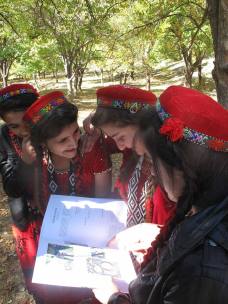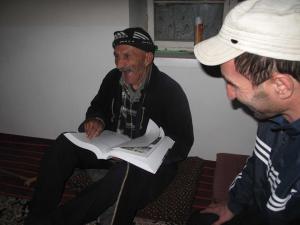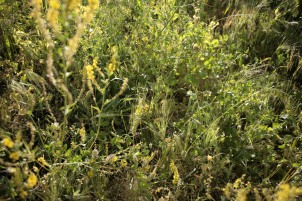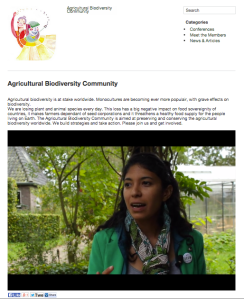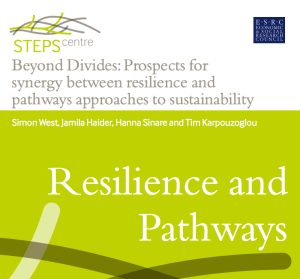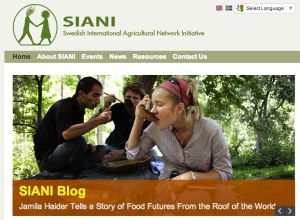At the Agricultural Biodiversity Community (ABC) meeting in Boxtel, Netherlands at the beginning of October, practitioners, farmers, and researchers from Africa, Europe, Asia, North and South America came together and created a process for “Resilience Self Assessment by Communities.”
This was the fourth meeting of the ABC, and three working groups worked over four days on i) policy outreach, ii) open source seed systems, and iii) resilience assessment (the group I was involved with).
Why did we have a working group on resilience assessment for agricultural biodiversity? This was my understanding prior to helping facilitate the workshop:
- There is an increasing demand from the international development community to ‘improve’ resilience of communities. Most communities, especially rural communities who are custodians of agricultural biodiversity, already have sources of resilience but assessment tools could help them identify and communicate this to external actors;
- The Resilience Assessment Workbook for Practitioners is seen as an important and useful resource but with limitations for communities in a development context to use this themselves;
- To share and synthesise knowledge and best practice amongst all the experts gathered here.
This matters because far too often external interventions, with altruistic motivations actually do the opposite of build resilience, and reduce diversity and erode local knowledge and culture that has maintained agricultural diversity for centuries (also the topic of my PhD).
Then there were two immediate contradictions to my initial understanding:
- Bioversity International, Satoyama Initiative, UNDP have been developing a toolbox for resilience assessment in agricultural biodiversity contexts based on the Social-Ecological Production Landscapes indicators (See also van Oudenhoven et al. 2010), and was launched at the CBD COP last week. So, what was the value added of our exercise?
- In the first session on the first day where we discussed setting the agenda as a group, many group participants said: “we don’t need a resilience assessment tool; we already do this in our communities and the last thing we need is some external perspective on what we already do.”
So, we threw our facilitation plans out the window.
In this first open session, many of the participants were asking what is Resilience anyways? The Thai and Ugandan farmer were saying that this is an English word and concept and might now be useful for them or their communities in their contexts.
We started by breaking down Why, How and What: resilience assessment?
WHY? We came to a shared understanding that what we wanted was a self-assessment by communities: for communities to a) identify and monitor sources and status of resilience in their communities for themselves, and b) in some contexts, to communicate to external actors and thereby possibly avoiding inappropriate development interventions.
HOW? Develop a process for communities to self assess resilience.
WHAT? The first part of this was to answer: what is resilience in agricultural biodiverse landscapes?
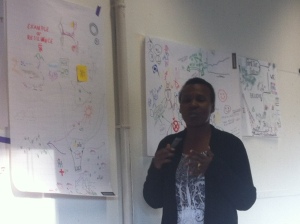
Angoli cattle farmer Elizabeth telling a narrative about resilience in her community.
We listened to the narrative of our Ugandan farmer colleague, who rears Angoli cattle and the group drew this story on large sheets of paper. She told us how if she loses one cow due to some misfortune, her community will give her five in return. And she will of course do the same if something happens to her friends’ cattle. Our Thai friend, an agro-forestry farmer, then told us how she does agro-forestry because ‘she is lazy’ and it’s so easy to let the fruit and vegetables grow without her input. Her livelihood depends entirely on her forest. In a community context, she depends a lot on the connections she has with her extended family and neighbours, who all specialise in different products and share their wealth with each other. Finally, our Indian colleague led a narrative of why we need to assess resilience.
The first day ended with a shared understanding of what resilience meant to us, and why we, in our own communities, wanted to assess it.
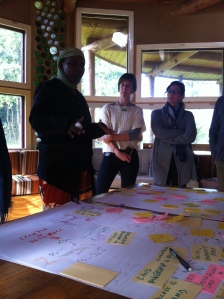
Identifying resilience attributes in agricultural biodiversity landscapes.
Our next steps as a group were to use the drawings to draw out attributes that were important to the custodians of the landscape. We used sticky notes on the big flipchart sheets for this. At the end, we had more than a list of attributes, but an understanding of what we valued in this community, and “what made it healthy and strong.”
Taking a step back, we created a mindmap of the Process we were in the middle of, and what this might look as tool to share. Here is our mindmap:
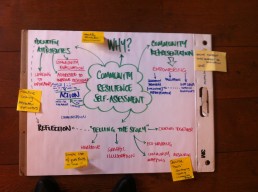
1. Why is an assessment needed?
2. Who should be involved? How to achieve equitable representation.
3. Telling the Story
4. Identify attributes
5. Link to Action
6. Reflection
The Agricultural Biodiversity Community is now in the process of pulling together resources to populate each of these steps with the expertise of the members of the group. For example, from MELCA in Ethiopia, experience with Eco-Mapping, and SeaRice, with community mapping. We are preparing a web-launch of this tool early 2015, which will link to other great resources, such as the RA workbook, a new E-learning course on Resilience Assessment by SwedBio to be launched soon, and the Satoyama tools.
Many of us left saying that we had achieved much more than we had ever expected. Farmers and practitioners left the workshop saying that this is definitely a tool that they can use in their communities. We will start field trials in Thailand, Uganda, South Africa, Peru, India and other countries early 2015.
As a researcher studying resilience in agricultural biodiversity landscapes, I left thinking that we achieved a milestone in co-creating a process that is accessible to communities and that we made a contribution in aggregating existing tools assessing resilience in agricultural biodiversity contexts, moving towards a specified assessment. We look forward to connecting this to the many other ongoing initiatives to assess resilience.
On a personal note, I found the workshop very challenging, but incredibly rewarding. Despite dedicating my work to smallholders, being a lover and advocate of wheats, millets, pulses and everything else, at the end of the day I am a young Northern female scientist. And my voice, especially at the beginning without any personal trust behind it, held very little legitimacy in this context. And I wouldn’t want it any other way. But, it makes it very difficult to contribute, let alone facilitate a co-creative process like this. Over time, as we got to know each other, these barriers broke down. But wow, it was humbling! I am so grateful for an incredible learning experience, where I also started a process of finding a space for my own voice in this critically important issue of conserving agricultural biodiversity that we all share a passion for.

Dutch farmer Jan at Eemlandhoeve.
